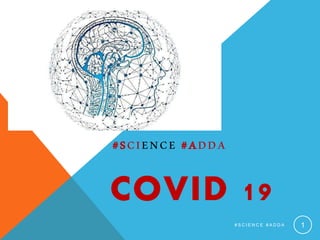Corona virus disease 2019 - Covid 19
- 1. #SCIENCE #ADDA # S C I E N C E # A D D A 1 COVID 19
- 2. WHAT IS COVID 19 ? ? Popularly know as Corona Virus Disease 2019 or COVID 19. ? Initially called as Severe acute respiratory syndrome-Corona Virus (SARS- CoV) ? First detected in human, mainly transmitted through animals in the year 2003, open air market, Guangdong province, china. ? In the same year, scientists reported the source of virus is horseshoe Bats (Rhinolophus sinicus) and quickly spreads through humans and can cause severe respiratory disease. Especially, difficulty in breathing, cough & cold. ? Most of these viruses have never been detected in humans, but a lot of them are genetically similar to some known human viruses under Beta-coronavirus genus category. ? Horseshoe Bats Horseshoe Bats # S C I E N C E # A D D A 2
- 3. CONT. The beta-coronaviruses have 4 ancestries that is, ? Lineage A ? Lineage B SARS CoV-2 or COVID 19 ? Lineage C ? Lineage D ? Only Lineage B have SARS-CoV and SARS CoV-2 or COVID 19, with approximately 200 published virus sequences ? Lineage C, Middle East respiratory syndrome-related coronavirus (MERS- CoV) and with over 500 viral sequences. ? Virus can cause both respiratory and intestinal infections in human and animals. ? The first suspected cause reported was pneumonia like cases in Wuhan have been linked with seafood and animal market. # S C I E N C E # A D D A 3
- 4. CURRENT SCENARIOS ? Corona virus first re-appear in mid-December 2019 at Wuhan city, China with variable symptoms like Fever, Cough, invasive lesions and difficulty in breathing. ? Researchers confirmed 6 sequences of Corona Virus associated with Wuhan tragedy. ? Initially, The IMPERIAL COLLEGE OF LONDON, estimated that, there may be 1700 cases in the Wuhan city and possibility of spreading to countries like Japan, Thailand, South Korea and USA. # S C I E N C E # A D D A 4
- 5. CONT. ? But things got more worsen than the data predicted by virological.org and (GISAID) global initiative on sharing influenza data. ? Now the corona virus shaped into a Global pandemic from epidemic. Its human to human transmission created a public health emergency (WHO) and serious economic crisis worldwide. ? Inability to supply of diagnostic-test kits, ventilators and masks has put the entire mankind in danger. ? Healthcare-workers lacking support of govt. on the mask, proper sanitization facility. # S C I E N C E # A D D A 5
- 6. RESEARCH GAP ? Every year, additional CoV sequences were discovered since 2003. However, there is a massive knowledge gap and does not have adequate research in the very field. ? Viral isolation from field samples is rarely successful. ? Reverse genetics recovery of recombinant virus is labour intensive and expensive. ? Development diagnostic-test kits ? Development of potential drugs. # S C I E N C E # A D D A 6
- 7. WORKING MECHANISM OF THE VIRUS ? Cell entry is an essential component of cross-species transmission of corona virus. Step 1: ? CoVs encode a surface glycoprotein (spike structures) and binds to the host-cell receptor. ? starts the process of viral entry Step 2: ? Then a single region of the spike protein called the receptor-binding domain (RBD) starts the interaction with the host-cell receptor. ? After binding the receptor, Step : 3 ? a nearby host protease cleaves the spike, which releases the spike fusion peptide. ? completes the process of virus entry. ? Known Host receptors for coronaviruses ? Angiotensin-converting enzyme 2 (ACE2) for SARS-CoV ? Dipeptidyl peptidase-4 (DPP4) for MERS-CoV # S C I E N C E # A D D A 7
- 8. GRAPHICAL IMAGE OF MECHANISM # S C I E N C E # A D D A 8
- 9. # S C I E N C E # A D D A 9 Graphical presentation of number of confirm cases till 03-04-
- 10. WORLDWIDE STATS OF CORONA PANDEMIC TILL 7 APRIL 2020 # S C I E N C E # A D D A 10
- 11. COMMON THINGS TO KNOW People may be sick with the virus for 1 to 14 days before developing symptoms. The most common symptoms of coronavirus disease (COVID-19) are fever, tiredness, and dry cough. Most people (about 80%) recover from the disease without needing special treatment. More rarely, the disease can be serious and even fatal. Older people, and people with other medical conditions (such as asthma, diabetes, or heart disease), may be more vulnerable to becoming severely ill. People may experience: cough fever tiredness difficulty breathing (severe cases) # S C I E N C E # A D D A 11
- 12. REFERENCES ? Letko, M., Marzi, A. and Munster, V., 2020. Functional assessment of cell entry and receptor usage for SARS-CoV-2 and other lineage B betacoronaviruses. Nature microbiology, 5(4), pp.562-569. ? of the International, C.S.G., 2020. The species Severe acute respiratory syndrome-related coronavirus: classifying 2019-nCoV and naming it SARS-CoV-2. Nature Microbiology, p.1. ? Huang, C., Liu, W.J., Xu, W., Jin, T., Zhao, Y., Song, J., Shi, Y., Ji, W., Jia, H., Zhou, Y. and Wen, H., 2016. A bat-derived putative cross-family recombinant coronavirus with a reovirus gene. PLoS pathogens, 12(9). ? COVID-19 | MyGov.in ? http://virological.org/ ? https://google.com/covid19-map/?hl=en ? https://www.google.com/search?sxsrf=ALeKk02UVLUKMy_iEFO4FvQSeyVG8Klu5g%3A1586267 244064&source=hp&ei=bISMXs_RAfnVz7sPpJOJuAE&q=covid+19&oq=covi&gs_lcp=CgZwc3kt YWIQAxgAMgQIIxAnMgQIABBDMgcIABCDARBDMgUIABCDATIHCAAQgwEQQzIHCAAQg wEQQzIHCAAQgwEQQzIFCAAQgwEyBAgAEEMyBAgAEEM6AggAOgcIABAUEIcCShUIFxIR MGc1MzFnMjk5ZzI0MmcyMjlKDQgYEgkwZzFnMWcxZzFQimdYrXBg43toAnAAeACAAd4DiA GRCZIBBzItMy4wLjGYAQCgAQGqAQdnd3Mtd2l6&sclient=psy-ab THANK YOU #SCIENCE #ADDA 12












